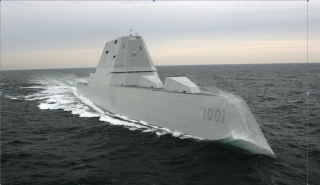
The second Zumwalt-class guided-missile destroyer has completed acceptance trials last week, according to a statement from Naval Sea Systems Command.
Michael Monsoor (DDG-1001) is now pier-side at General Dynamics Bath Iron Works in Maine after the Navy evaluation ahead of delivery to the service in March.
The second ship in the three-ship class conducted a battery of tests at the shipyard and underway in the Atlantic Ocean overseen by the Navy’s Board of Inspection and Survey.
“[INSURV] reviewed the ship and its crew during a series of demonstrations both pierside and underway, evaluating the ship’s construction and compliance with Navy specifications,” according to the NAVSEA statement.
“Many of the ship’s onboard systems including navigation, damage control, mechanical, electrical, combat, communications, and propulsion systems were tested to validate performance met or exceeded Navy specifications.”
Monsoor’s first sets of builder’s trials were curtailed in December following problems discovered in the ship’s Integrated Power System.
“A harmonic filter aboard Michael Monsoor (DDG-1001) failed one day after the ship left the yard on Dec. 4,” NAVSEA told USNI News in December.
“Harmonic filters are used in complex electrical systems to prevent unintended power fluctuations from damaging sensitive equipment.”
The IPS is complicated propulsion system that gives the Zumwalt-class massive power capability for a non-nuclear ship. The system is built around two Rolls Royce MT-30 gas turbines and two Rolls Royce MT-5 auxiliary gas turbines that can generate 75 megawatts.
Monsoor is the second of the three-ship, 23-billion class of guided-missile destroyers. The third, Lyndon B. Johnson (DDG-1002) is still under construction.
The following is the complete Feb. 2, 2018, statement from Naval Sea Systems Command
BATH, Maine — The Navy’s next generation destroyer, the future USS Michael Monsoor (DDG 1001), successfully completed acceptance trials on Feb. 1.
The U.S. Navy’s Board of Inspection and Survey reviewed the ship and its crew during a series of demonstrations both pier side and underway, evaluating the ship’s construction and compliance with Navy specifications.
Many of the ship’s onboard systems including navigation, damage control, mechanical, electrical, combat, communications, and propulsion systems were tested to validate performance met or exceeded Navy specifications.
“DDG 1001 performed exceedingly well during acceptance trials,” said Capt. Kevin Smith, DDG 1000 class program manager, Program Executive Office (PEO) Ships. “The industry and Navy team worked together to incorporate lessons learned from DDG 1000. The trials once again demonstrated how truly powerful and exceptional these ships are. ”
Zumwalt class destroyers feature a state-of-the-art electric propulsion system, wave-piercing tumblehome hull, stealth design and are equipped with some of the most advanced warfighting technology. These ships will be capable of performing a range of deterrence, power projection, sea control, and command and control missions while allowing the Navy to evolve with new systems and missions.
DDG 1001 was christened in June 2016, and is scheduled to deliver in the coming months. BIW is currently in production on the future USS Lyndon B. Johnson (DDG 1002), as well as future Arleigh Burke class destroyers Thomas Hudner (DDG 116), Daniel Inouye (DDG 118), Carl M. Levin (DDG 120) and John Basilone (DDG 122).
As one of the Defense Department’s largest acquisition organizations, PEO Ships is responsible for executing the development and procurement of all destroyers, amphibious ships, special mission and support ships, and special warfare craft.





